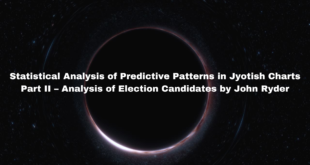Related Articles
Editor: Yenbeeyes
Publisher’s Note:
After publishing the first part of the 7 lessons from the book written by Sri Vaidya Nathan, Mr. Venkataraman Subramanian contacted us and informed us that he was a student of Sri Vaidyanathan. Since he has studied under the author of the book, he must have been well informed and might also have some more finer techniques which he might have learned from his Guru. Hence upon our request he has agreed to go through the rest of the translations and offer his expert comments.
We are fortunate enough to get the contact of a person who has learnt Samakkol Arudham direct from the writer of the book which is being translated by us. A few words about our expert commentator Sri Venkataraman Subramanian will be essential here:
For the first of the 7 lessons which has already been published he has given the expert comments which are reproduced below.
Also we have been giving the North Indian Chart format also in all the lessons. But Sri Vaidhyanathan has the following to say on this point:
In the first seven lessons we have adopted North Indian chart as well. Actually I have already stated in my first mail that the North Indian charts cannot be followed as the planets are entered inside the chart and outside the chart. This difference is actually necessary and distinguish this system from other systems of prashna. The outer planets alone have been used by present day followers of this system and the results are perfect no doubt. But Shri Vaidhyanathan was not in favour of this argument. He wanted to use both transit of planets and outer planets.
Also a table is given at the end of the comments which will be useful in fixing the Tamil dates from the English dates which are currently in use.
Comments of Sri Venkataraman Subramnian ex student of Sri Vaidhya Nathan
SAMAKKOL ARUDAM – LESSON NO 3
Determination Of Udayam
Different Method
The Lesson 3 of Samakkol Arudam written by Shri Vaidhyanathan confirms with the provisions of Jinendramala. The following method is also in vogue in South Tamil Nadu. Let me explain the method clearly.
For understanding this method of determining the Udayam, the following table is essential. The details of sunrise and sun set are not taken in to account in this method. However, the day and month (Tamil month) is reckoned in this method.
Determination Of Dhuruva Number
DAY | DHURUVA NUMBER | DAY | DHURUVA NUMBER |
1 | 60 | 16 | 30 |
2 | 58 | 17 | 28 |
3 | 56 | 18 | 26 |
4 | 54 | 19 | 24 |
5 | 52 | 20 | 22 |
6 | 50 | 21 | 20 |
7 | 48 | 22 | 18 |
8 | 46 | 23 | 16 |
9 | 44 | 24 | 14 |
10 | 42 | 25 | 12 |
11 | 40 | 26 | 10 |
12 | 38 | 27 | 8 |
13 | 36 | 28 | 6 |
14 | 34 | 29 | 4 |
15 | 32 | 30/31/32 | 2 |
In Tamil months we get 30 or 31 or 32 days.
We now calculate Udayam
Suppose we are given the following data for which we are to determine the Udayam.
Chiththarai Month 10th day Friday at 10:24 AM. This time we take as Aruda time.
From Dhuruva Number table, for the tenth day we have the figure as 42.
From the required time (10:24) the hour is removed and take the minute. The minute here is less than the dhuruva number. The rule is given hereunder:
- If dhuruva number is either equal to or more than the minute column of Aruda time, deduct 5 from the hours of Aruda time. Here aruda time – minutes is 24 but dhuruva number is 42. So 5 is deducted from the hour namely 10. The result is 5. This resultant figure may be termed as Rasi Number. Here the month for which we are determining Udayam falls in Chiththarai. It denotes Mesha or Aries. From this sign find the 5th Here it is Leo and Leo will be Udayam
- Suppose, dhuruva number is less than the minute of the aruda time, deduct 4 from the hour of aruda time. Select the Rasi Number.
We shall now take the example provided by Shri Vaidyanathan in his book.
August 6 Friday at 11 AM
In tamil month it is 22nd of Ashada month.
Now we calculate Dhuruva number and Rasi Number for the time as per this alternate method.
The Dhuruva number for 22 is 18.
The rule number 1 is applicable here as the minute of the Aruda time(11.00) is lesser than dhuruva number (18) and hence the Rasi number will be 5. The rasi number(5) is deducted from the hour (11)of aruda time. The resultant figure is 6. Now sun during Ashada month will be transiting in Cancer. From Cancer sign, this figure of 6 is added to get the Udayam in Sagittarius sign. This example in Lesson 3 also shows Sagittarius or Dhanur sign.
Surya Veedhi
But I have found the following practice by some of the followers of Samakkol Arudam:
Surya Veedi consists of Leo to Capricorn clock-wise.
Chandra Veedi consists of Aquarius to Cancer If Udayam occurs in this surya Veedi, it is termed suba udayam If Arudam occurs in this chandra veedi, it is termed suba Arudam
If Udayam occurs in Chandra veedi then it is termed asuba Udayam If Arudam occurs in Surya Veedi then it is termed asuba Arudam
If both Udayam and Arudam falls under suba category, the answer will be subam If both Udayam and Arudam falls under asuba category, the answer will also be asubam
Note: The above rule is subjected to the condtion that there are no planets in both Udayam and Arudam
TABLE FOR FINDING TAMIL CALENDER (START DATE) FROM ENGLISH CALENDER |
Month(Tamil) —> | 1 | 2 | 3 | 4 | 5 | 6 | 7 | 8 | 9 | 10 | 11 | 12 |
Month (English) –> | A | B | C | D | E | F | G | H | I | J | K | L |
Year | Date | Date | Date | Date | Date | Date | Date | Date | Date | Date | Date | Date |
2013-2014 | 14 | 15 | 15 | 17 | 17 | 17 | 18 | 17 | 16 | 14 | 13 | 15 |
2014-2015 | 14 | 15 | 15 | 17 | 17 | 17 | 18 | 17 | 16 | 15 | 13 | 15 |
2015-2016 | 14 | 15 | 16 | 17 | 18 | 18 | 18 | 17 | 17 | 15 | 13 | 14 |
2016-2017 | 14 | 14 | 15 | 16 | 17 | 17 | 17 | 16 | 16 | 14 | 13 | 14 |
2017-2018 | 14 | 15 | 15 | 17 | 17 | 17 | 18 | 17 | 16 | 14 | 13 | 15 |
2018-2019 | 14 | 15 | 15 | 17 | 17 | 17 | 18 | 17 | 16 | 15 | 13 | 15 |
2019-2020 | 14 | 15 | 16 | 17 | 18 | 18 | 18 | 17 | 17 | 15 | 13 | 14 |
Note: | ||||||||||||
Against Tamil Month I have shown 1-Chiththirai 2-Vaikashi 3-Aani 4. Aadi 5. Avani | ||||||||||||
6. Purattasi 7. Ayippasi 8.Karthikai 9. Marghazhi 10. Thai 11. Masi 12 Panguni | ||||||||||||
Against English Calender I have shown A -April B- May C-June D- July E-August | ||||||||||||
F-September G-October H- November I- December J -January K – February L – March | ||||||||||||
How to use the table: | ||||||||||||
Suppose we need to find the Tamil Month and Date for English date 14th April 2013 | ||||||||||||
Against the year 2013-2014 under the column A ( A means April) it is mentioned as 14. | ||||||||||||
If we check the row against Tamil Calender, we get 1 (1 is shown as Chiththirai) | ||||||||||||
Hence 14th April 2013 (English Calender) will be Chiththirai 1 of Tamil Calender. | ||||||||||||
Suppose we need to find the Tamil Month and Date for English Date: 24th April 2013 | ||||||||||||
We have calculated in our first example that 14th April 2013 as per English Calender will | ||||||||||||
refer to Chiththrai 1 of Tamil Calender. Now we want to know the corresponding | ||||||||||||
Tamil Calender month and date for 24th April 2013. 10 days have passed. | ||||||||||||
So in Tamil Calender also 10 days should pass. | ||||||||||||
Learn Astrology: Join Our Upcoming Astrology Classes — Click Here
Learn Astrology: Join Our Recorded Astrology Classes — Click Here
 Saptarishis Astrology Magazine Into Creating Astrologers
Saptarishis Astrology Magazine Into Creating Astrologers






